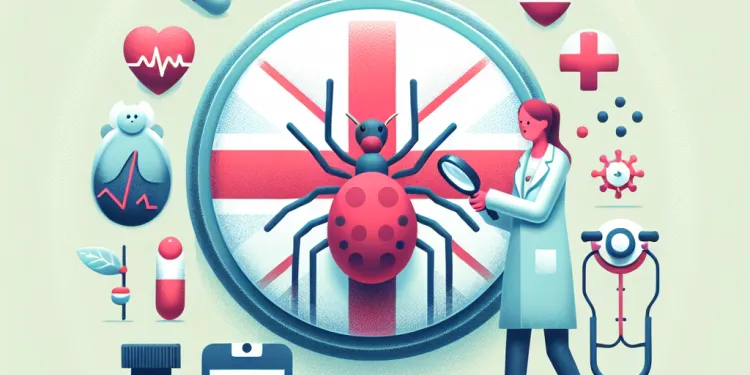Find Help
More Items From Ergsy search
-

What is Lyme Disease?
Relevance: 100%
-

Lyme disease: What is it?
Relevance: 99%
-

Is there a vaccine for Lyme disease?
Relevance: 98%
-

Can Lyme disease be treated?
Relevance: 96%
-

How is Lyme disease transmitted?
Relevance: 95%
-

Is Lyme disease contagious between humans?
Relevance: 92%
-

Can pets get Lyme disease?
Relevance: 92%
-

What are common symptoms of Lyme disease?
Relevance: 92%
-

What is the first sign of Lyme disease?
Relevance: 90%
-

How do you prevent Lyme disease?
Relevance: 90%
-

Where is Lyme disease most commonly found?
Relevance: 89%
-

What happens if Lyme disease is left untreated?
Relevance: 89%
-

What tests are available for diagnosing Lyme disease?
Relevance: 88%
-

What kind of ticks carry Lyme disease?
Relevance: 88%
-

How effective are antibiotics in treating Lyme disease?
Relevance: 88%
-

Can you get Lyme disease more than once?
Relevance: 83%
-

What is post-treatment Lyme disease syndrome (PTLDS)?
Relevance: 80%
-

Can Lyme disease cause long-term health problems?
Relevance: 59%
-

What types of antibiotics are typically used to treat Lyme disease?
Relevance: 58%
-

How long does a tick need to be attached to transmit Lyme disease?
Relevance: 55%
-

Tick Bites: Should you be worried?
Relevance: 45%
-

Coeliac disease
Relevance: 34%
-

Coeliac Disease: Session 1: What is Coeliac Disease?
Relevance: 34%
-

Is Huntington's disease fatal?
Relevance: 33%
-

Liver disease | NHS
Relevance: 33%
-

Is Crohn's disease contagious?
Relevance: 33%
-

Causes of coeliac disease
Relevance: 32%
-

What is Huntington's disease?
Relevance: 32%
-

Is there a cure for Crohn's disease?
Relevance: 32%
-

What is Mitochondrial disease?
Relevance: 32%
-

What is Parkinson's disease?
Relevance: 32%
-

Symptoms of coeliac disease
Relevance: 32%
-

Do UK mosquitoes carry diseases?
Relevance: 32%
-

What is Alzheimer's disease?
Relevance: 32%
-

Do spiders in the UK carry diseases?
Relevance: 31%
-

What causes Crohn's disease?
Relevance: 31%
-

What causes Huntington's disease?
Relevance: 31%
-

How is Crohn's disease diagnosed?
Relevance: 31%
-

Can Huntington's disease be prevented?
Relevance: 31%
-

What is sickle cell disease?
Relevance: 31%
Lyme Disease: An Overview
What is Lyme Disease?
Lyme disease is an infectious disease caused by the Borrelia bacterium, which is typically transmitted to humans through the bite of an infected black-legged or deer tick. The disease is named after the town of Lyme, Connecticut, where it was first identified in 1975. It can lead to a wide range of symptoms and, if left untreated, can become a chronic debilitating condition.
Symptoms of Lyme Disease
The symptoms of Lyme disease can vary depending on the stage of infection. Early signs often include a characteristic “bull's-eye” rash called erythema migrans, fever, chills, headache, fatigue, muscle and joint aches, and swollen lymph nodes. If left untreated, the infection can spread to joints, the heart, and the nervous system, leading to more severe symptoms such as Lyme arthritis, neurological problems, and heart palpitations.
Prevalence in the United Kingdom
Lyme disease is a concern in the United Kingdom, particularly in rural areas with a high population of deer and other wildlife. Areas such as the South of England, the Scottish Highlands, and some parts of Northern Ireland see higher incidence rates of Lyme disease. Public awareness of the disease and its symptoms is crucial for early diagnosis and treatment.
Diagnosis and Treatment
Lyme disease is diagnosed based on symptoms, physical findings (such as the bull's-eye rash), and the likelihood of exposure to infected ticks. Blood tests can also help to diagnose the disease. The standard treatment for Lyme disease is a course of antibiotics, usually doxycycline, amoxicillin, or cefuroxime axetil. Early treatment is essential to prevent chronic complications.
Prevention
Preventing tick bites is the best way to avoid Lyme disease. This can be done by wearing long-sleeved clothing and trousers when walking in wooded or grassy areas, using tick repellents, and performing regular tick checks after outdoor activities. If a tick is found attached to the skin, it should be removed promptly and properly using fine-tipped tweezers.
Conclusion
Lyme disease is a preventable and treatable condition, but public awareness and education are crucial. In the United Kingdom, understanding the risk areas and taking preventive measures can significantly reduce the incidence of Lyme disease. Early recognition of symptoms and prompt medical treatment are key to avoiding long-term health issues.
Lyme Disease: An Overview
What is Lyme Disease?
Lyme disease is an illness you can get from tick bites. Ticks are tiny bugs. If a tick bites you and it has a germ called Borrelia, you might get sick. Lyme disease got its name from a town called Lyme in the USA, where it was first found. If you don't treat it, it can make you very sick for a long time.
Symptoms of Lyme Disease
If you have Lyme disease, you might see a special rash that looks like a target, with a red circle and a clear center. You might also feel like you have the flu with fever, chills, headaches, and feel very tired and achy. If it gets worse, it can affect your joints, heart, and brain. This can cause more pain, trouble thinking, or your heart to beat funny.
Prevalence in the United Kingdom
Lyme disease can happen in the UK, especially in countryside areas with a lot of deer. Places like the South of England, the Scottish Highlands, and some parts of Northern Ireland have more cases. It is important for people to know about Lyme disease so they can get help early.
Diagnosis and Treatment
Doctors figure out if you have Lyme disease by looking at your symptoms, checking for the special rash, and asking if you have been in places where ticks live. They might do a blood test too. If you have Lyme disease, you will need to take medicine called antibiotics to get better. It's important to start treatment early.
Prevention
The best way to avoid Lyme disease is to prevent tick bites. Wear long sleeves and trousers when you are in the woods or grassy places. Use bug spray for ticks, and check your skin for ticks after being outside. If you find a tick on you, gently remove it with tweezers right away.
Conclusion
Lyme disease can be stopped and treated easily, but people need to know about it. In the UK, learning where Lyme disease is common and how to keep ticks away can help a lot. Knowing the signs of Lyme disease and getting treatment quickly can stop it from causing serious health problems later.
Frequently Asked Questions
What is Lyme disease?
Lyme disease is an infectious disease caused by the bacterium Borrelia burgdorferi, which is transmitted through the bite of infected black-legged ticks.
How common is Lyme disease in the UK?
Lyme disease is relatively uncommon in the UK, but cases have been increasing over recent years. It’s most often reported in areas with woodlands and grassy spaces.
What are the typical symptoms of Lyme disease?
The early symptoms often include a red circular rash (erythema migrans) that spreads from the site of the tick bite, fever, headache, fatigue, and muscle and joint pains.
How is Lyme disease diagnosed?
Diagnosis is primarily based on symptoms, history of tick exposure, and sometimes, blood tests that detect antibodies against the bacterium.
Can Lyme disease be treated?
Yes, Lyme disease can usually be treated successfully with a course of antibiotics, especially if diagnosed early.
What happens if Lyme disease is not treated?
If left untreated, the infection can spread to joints, the heart, and the nervous system, potentially causing serious complications.
Can you get Lyme disease more than once?
Yes, having had Lyme disease before does not protect you from getting it again. You can be re-infected if bitten by another infected tick.
How can I protect myself from Lyme disease?
Avoid tick habitats, use insect repellent, wear long-sleeved shirts and long trousers, and perform thorough tick checks after being outdoors.
What should I do if I find a tick on my skin?
Use fine-tipped tweezers to grasp the tick as close to the skin’s surface as possible and pull upward with steady, even pressure. Clean the bite area and your hands with rubbing alcohol or soap and water.
Where in the UK is Lyme disease most prevalent?
Lyme disease is most commonly reported in southern and southeastern England, as well as parts of Scotland and the Lake District.
Can pets get Lyme disease?
Yes, pets, especially dogs, can get Lyme disease. It’s important to check them regularly for ticks and consult a vet for the best preventive measures.
Is there a vaccine for Lyme disease?
Currently, there is no vaccine for humans, but there is a vaccine available for dogs.
Can Lyme disease be transmitted from person to person?
No, Lyme disease is not contagious and cannot be transmitted from person to person.
Are tick bites the only way to get Lyme disease?
Yes, Lyme disease is only transmitted through the bite of an infected black-legged tick, also known as a deer tick.
What is the best time of year to be cautious about ticks?
Ticks are most active from late spring through early autumn, but they can be encountered year-round in some areas.
What is Lyme disease?
Lyme disease is an illness you can get from tick bites.
Ticks are tiny bugs that live in woods and tall grass.
If a tick bites you, you might get sick.
Look out for a red spot or a rash where the tick bit you.
Ways to stay healthy:
- Wear long clothes when in grassy areas.
- Check for ticks on your skin after being outside.
- If you see a tick on you, ask an adult to help remove it.
If you feel unwell, talk to a doctor.
Lyme disease is a sickness you can get from a germ called Borrelia burgdorferi. You can catch it if a tick with the germ bites you.
How often do people get Lyme disease in the UK?
Lyme disease is an illness you can get from ticks.
It is not very common in the UK.
If you spend time in grassy or woodland areas, you can use tick repellent to stay safe.
Check your skin for ticks after being outdoors.
If you're worried, talk to a doctor.
Lyme disease is not very common in the UK, but more people have been getting it in the last few years. It happens mostly in places with lots of trees and grass.
What are the usual signs of Lyme disease?
Lyme disease is an illness you can get from a tick bite. Ticks are tiny bugs.
Here are the usual signs:
- Red Spot: You might see a red spot on your skin where the tick bit you. It can look like a "bull's-eye."
- Feeling Tired: You may feel very tired and want to sleep a lot.
- Fever: You might have a high body temperature.
- Headache: Your head may hurt a lot.
- Aches: Your muscles and joints might feel sore.
If you think you have Lyme disease, ask a doctor for help.
You can use tools to help read:
- Text-to-Speech: This tool reads words out loud to you.
- Picture Stories: These use pictures to help explain words.
When you get bitten by a tick, you might see a red rash that looks like a circle. It can get bigger. You might also get a high temperature (fever), a sore head, feel very tired, and have sore muscles and joints.
If you have these symptoms, tell an adult and go to see a doctor. They can help you feel better.
Using a calendar to track when these symptoms happen can help you remember to tell the doctor.
How do doctors find out if someone has Lyme disease?
Doctors use tests to find out if someone has Lyme disease. They ask people how they feel and check for signs. Sometimes, they might take a blood test.
Here are some things that might help:
- Ask questions if you don’t understand.
- Bring someone with you to help you remember what the doctor says.
- Use pictures or drawing to show how you feel.
The doctor finds out what's wrong by looking at: if you feel sick, if a tick bit you, and sometimes a blood test to see if your body is fighting the germ.
Can Lyme disease be treated?
Yes, Lyme disease can be treated.
If you have Lyme disease, you should see a doctor.
The doctor can give you medicine called antibiotics. These medicines help you get better.
It is important to start treatment early, so you feel better soon.
If you need help understanding this, you can ask someone you trust to explain it to you.
Using picture books and videos can also help you learn more.
Yes, medicine can mostly help get rid of Lyme disease. It works best if you start taking it soon after getting sick. The medicine your doctor will give you is called antibiotics.
What happens if Lyme disease is not treated?
If you don’t get medicine for Lyme disease, you might get more sick. Here’s what could happen:
- You might feel very tired and sore.
- You could have bad headaches.
- Your joints, like knees and elbows, might hurt a lot.
- You might have problems with your heart.
It is important to see a doctor and take medicine if you think you have Lyme disease.
Here are some things that can help you understand more:
- Ask someone you trust to read with you.
- Use apps that read text out loud.
- Look at pictures or watch videos about Lyme disease.
If you don't treat the infection, it can move to your joints, heart, and brain. This can cause big problems.
Can you have Lyme disease again?
Yes, you can get Lyme disease more than one time. Your body does not stay protected after the first time. If you are bitten by a tick again, you can get sick again.
Here are some tips to help:
- Use bug spray to keep ticks away.
- Check your skin for ticks after being outside.
- Wear long sleeves and pants to cover your skin.
- If you find a tick on you, tell an adult.
Yes, you can get Lyme disease more than once. If a tick with Lyme disease bites you again, you can be sick again.
How can I stay safe from Lyme disease?
Lyme disease is a sickness from a tick bite. Here's how to stay safe:
1. Cover up: Wear long sleeves and pants when you go outside.
2. Use tick spray: Put bug spray on your clothes and skin.
3. Check your body: Look for ticks after being outside. They are small bugs.
4. Stay on paths: Walk in the middle of trails. Try not to brush against plants.
5. Get help: Ask someone to check your hair and back for ticks. Use a mirror if you are alone.
6. Wash clothes: Put your clothes in a hot dryer to kill ticks.
These steps can help keep you safe. If you find a tick, tell an adult right away. They can help remove it.
Stay away from places where ticks live. Use bug spray. Wear shirts with long sleeves and long pants. Look carefully for ticks on your body after being outside.
What to Do if You Find a Tick on Your Skin
If you see a tick on your skin, don't worry. Here are some easy steps:
- Use a tick remover tool or tweezers to grab the tick close to your skin.
- Pull the tick out slowly and carefully.
- Wash the area with soap and water.
- Tell an adult if you feel unwell after.
You can use helpful tools like magnifying glasses to see better. It's okay to ask if you need help!
Use small tweezers to grab the tick very close to the skin. Pull it out slowly and gently. Wash the bite area and your hands with rubbing alcohol or soap and water to keep them clean.
Where in the UK do people get Lyme disease the most?
Lyme disease is a sickness you can get from ticks.
Ticks are tiny bugs that live in grass and trees.
You can get Lyme disease if a tick bites you.
Places where people get Lyme disease the most:
- South of England, especially in the New Forest area
- North of England, like the Lake District
- Scotland, particularly in the Highlands
Here are some tips to stay safe:
- Wear long sleeves and long trousers in grassy areas.
- Use tick repellent on your skin and clothes.
- Check your skin for ticks after being outside.
Bring a tick remover tool when you go to these places. It can help you if a tick bites you.
If you feel unwell after a tick bite, tell a doctor. They can help you feel better.
Lyme disease is most often found in the south and southeast of England. It is also found in some places in Scotland and the Lake District.
Can pets get sick from Lyme disease?
Lyme disease is an illness caused by tiny bugs called ticks.
Yes, pets like dogs and cats can get Lyme disease if a tick bites them.
If your pet gets Lyme disease, they might feel tired or have sore joints.
To help your pet, you can:
- Check your pet for ticks after they play outside.
- Ask the vet about tick medicines to protect your pet.
- Use a special comb to look for ticks in your pet's fur.
Yes, pets can get Lyme disease. Dogs can get it. Check your pets often for ticks. Talk to a vet to find out the best way to keep them safe.
Can you get a shot to stop Lyme disease?
Right now, there is no shot to stop people from getting sick. But there is a shot to help keep dogs healthy.
Can you catch Lyme disease from someone else?
No, you cannot catch Lyme disease from another person. You get Lyme disease from a tick bite.
If you need help understanding, you can:
- Ask a friend or family member to explain it to you.
- Use a picture or video to help you understand.
- Look for more information in books or online, but make sure it’s easy for you to read.
No, Lyme disease does not spread from one person to another. You cannot catch it from someone else.
Can you get Lyme disease without a tick bite?
Lyme disease is mostly spread by tick bites. Ticks are tiny bugs. Most people get Lyme disease after a tick bite.
If you think you have been bitten by a tick, tell a grown-up. They can help you see a doctor.
Watch out for these signs after a tick bite: a red spot or rash, feeling tired, fever, headaches, or sore muscles.
Yes, Lyme disease spreads when an infected tiny bug called a black-legged tick, or deer tick, bites you.
When should you watch out for ticks?
Ticks are small bugs. They are most active during late spring to early autumn. But in some places, you can find them all year round.
Useful Links
- Ergsy carfully checks the information in the videos we provide here.
- Videos shown by Youtube after a video has completed, have NOT been reviewed by ERGSY.
- To view, click the arrow in centre of video.
- Most of the videos you find here will have subtitles and/or closed captions available.
- You may need to turn these on, and choose your preferred language.
- Go to the video you'd like to watch.
- If closed captions (CC) are available, settings will be visible on the bottom right of the video player.
- To turn on Captions, click settings .
- To turn off Captions, click settings again.
More Items From Ergsy search
-

What is Lyme Disease?
Relevance: 100%
-

Lyme disease: What is it?
Relevance: 99%
-

Is there a vaccine for Lyme disease?
Relevance: 98%
-

Can Lyme disease be treated?
Relevance: 96%
-

How is Lyme disease transmitted?
Relevance: 95%
-

Is Lyme disease contagious between humans?
Relevance: 92%
-

Can pets get Lyme disease?
Relevance: 92%
-

What are common symptoms of Lyme disease?
Relevance: 92%
-

What is the first sign of Lyme disease?
Relevance: 90%
-

How do you prevent Lyme disease?
Relevance: 90%
-

Where is Lyme disease most commonly found?
Relevance: 89%
-

What happens if Lyme disease is left untreated?
Relevance: 89%
-

What tests are available for diagnosing Lyme disease?
Relevance: 88%
-

What kind of ticks carry Lyme disease?
Relevance: 88%
-

How effective are antibiotics in treating Lyme disease?
Relevance: 88%
-

Can you get Lyme disease more than once?
Relevance: 83%
-

What is post-treatment Lyme disease syndrome (PTLDS)?
Relevance: 80%
-

Can Lyme disease cause long-term health problems?
Relevance: 59%
-

What types of antibiotics are typically used to treat Lyme disease?
Relevance: 58%
-

How long does a tick need to be attached to transmit Lyme disease?
Relevance: 55%
-

Tick Bites: Should you be worried?
Relevance: 45%
-

Coeliac disease
Relevance: 34%
-

Coeliac Disease: Session 1: What is Coeliac Disease?
Relevance: 34%
-

Is Huntington's disease fatal?
Relevance: 33%
-

Liver disease | NHS
Relevance: 33%
-

Is Crohn's disease contagious?
Relevance: 33%
-

Causes of coeliac disease
Relevance: 32%
-

What is Huntington's disease?
Relevance: 32%
-

Is there a cure for Crohn's disease?
Relevance: 32%
-

What is Mitochondrial disease?
Relevance: 32%
-

What is Parkinson's disease?
Relevance: 32%
-

Symptoms of coeliac disease
Relevance: 32%
-

Do UK mosquitoes carry diseases?
Relevance: 32%
-

What is Alzheimer's disease?
Relevance: 32%
-

Do spiders in the UK carry diseases?
Relevance: 31%
-

What causes Crohn's disease?
Relevance: 31%
-

What causes Huntington's disease?
Relevance: 31%
-

How is Crohn's disease diagnosed?
Relevance: 31%
-

Can Huntington's disease be prevented?
Relevance: 31%
-

What is sickle cell disease?
Relevance: 31%


